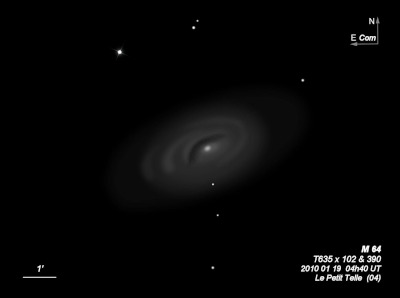Black Eye Galaxy,Evil Eye Galaxy
Black Eye Galaxy,Evil Eye Galaxy

Johann Bode is generally considered the discoverer of M64 = NGC 4826 = h1486 on 4 Apr 1779, but Edward Pigott discovered the Black Eye galaxy a few days earlier on 23 Mar 1779. Charles Messier independently rediscovered it on 1 Mar 1780. Pigott's discovery was announced in Philosophical Transactions of the Royal Society of London, Vol. LXXI (1781), p82-83, but was generally missed until 2002. See http://www.seds.org/messier/more/m064_pigott.html for more of the story.
The nickname "Black-eye" is from William Herschel's description on 13 Feb 1787 (sweep 699): "A very remarkable object, mE about 12' long, 4 or 5' broad, contains one lucid spot like a star with a small black arch under it, so that it gives one the idea of what is called a black eye, arising from fighting." His earlier observation on 13 Apr 1785 (sweep 398) reads "vB, E from np to sf, about 7 or 8' long and 2' broad. A vB nucleus in the middle, but moonlight and haziness probably lessen its appearance considerably. The nucleus is very small in proportion to the rest and is not round, but irreg elongated in the same direction."
John Herschel described his sketch as follows: "The dark semi-elliptic vacancy (indicated by an unshaded or bright portion in the figure) which partially surrounds the condensed and bright nucleus of this nebula, is of course unnoticed by Messier. It was however seen by my Father, and shown by him to the late Sir Charles Blagden, who likened it to the appearance of a black eye, an odd, but not inapt comparison. The nucleus is somewhat elongated, and I have a strong suspicion that it may be a close double star, or extremely condensed double nebula." So perhaps Blagden first mentioned the term and William liked the analogy used it in his description.
At least 18 observations of the "black eye" were made at Birr Castle. On 11 Mar 1848 (one of the earliest descriptions): "curious circular-shaped nebula, with a dark and large spot at one side, around which is a close cluster of well-defined little stars." Using his 48-inch on Malta, William Lassell's sketch from 22 Apr 1862 showed the "remarkable dark space" as distinctly crescent-shaped and he noted it appeared "as dark as any part of the surrounding sky."
300/350mm - 13.1" (4/29/84): very bright, large, oval 2:1 WNW-ESE, 6'x3', small bright core, almost stellar nucleus. The famous curved dark patch or "Black Eye", located just northeast of the core, was quite prominent and visible with direct vision. Located 55' NE of the tight double star 35 Comae.
Notes by Steve Gottlieb